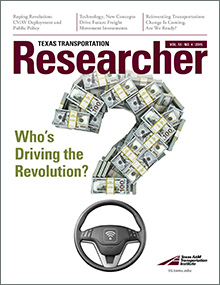Although we often take the safe, efficient movement of freight for granted, our local and global economies depend on it. Whatever the path — highways, railways, waterways, airports, ports of entry, pipelines — reliably getting goods to market drives the heartbeat of our economy.

Texas A&M Transportation Institute (TTI) researchers are at the forefront of freight mobility research, investigating innovative technologies and analytical approaches to ensure the efficient movement of goods to market.
Getting the Future of Texas Freight Movement on Track
“In Texas, freight transportation is at a crossroads,” explains Curtis Morgan, manager of TTI’s Multimodal Freight Program. “We have to make critical improvements soon in both efficiency and capacity to prepare for big changes coming in the next 25 years.” According to a draft of the Texas Department of Transportation’s (TxDOT’s) Freight Mobility Plan, by 2040, the Texas population is expected to grow from 26 million to 45 million residents, with an increase in goods moved per year from 2.6 billion to 3.8 billion tons.
Morgan and his team are finishing an initial report for TxDOT that identifies more than 50 innovative or automated freight strategies and technologies from around the world. Among these are the use of automated and driverless trucks, specialized software that connects all the operators in a supply chain, truck-only roadways, and the unmanned aerial vehicle delivery of goods.
“For each freight strategy we evaluated, we looked at how it works, its potential use in Texas compared to how it’s used elsewhere, and costs associated with implementation and use,” Morgan says. “Our next job is to help TxDOT narrow down the possibilities to the ones that make the most sense for future deployment in Texas.”
Freight Fluidity: TTI’s New Approach to Measuring Shipping Efficiencies
To improve the reliability and efficiency of its supply chains, Transport Canada coined the term freight fluidity to describe a new way of measuring the various freight components of the overall transportation system.
“Transport Canada turned to TTI because of our extensive experience with performance measures developed as part of the Urban Mobility Scorecard, including freight measures,” says Bill Eisele, senior research engineer and manager of TTI’s Mobility Analysis Program. “With those tools, we helped them develop travel-time-based measures to monitor their global supply chains. Since then, the freight fluidity concept has gained tremendous momentum at the national level in the United States and with individual states.”
Eisele is now working extensively with University of Maryland researchers to implement freight fluidity in Maryland.
“Freight movement in a safe, efficient and reliable manner is a key priority for our administration and rightly so,” says Subrat Mahapatra, transportation manager of the Maryland Department of Transportation State Highway Administration. “The better we can understand what’s on the road and where, the better we can operate our systems, plan transportation investments, and ensure goods are moving most efficiently to serve our people and businesses. TTI is helping us with that.”
The growing popularity of the freight fluidity concept is keeping Eisele and other TTI researchers, like Juan Villa, busy. Villa, TTI’s regional manager for Latin America, has extensive experience studying freight movements across the congested Texas-Mexico border. The freight fluidity approach has opened the door to a more comprehensive way of looking at the problems associated with moving goods across the border.
“With freight fluidity, we take into consideration the entire supply chain,” says Villa. “We can now identify potential improvements to the transportation system based on performance measures that analyze not only network congestion or border wait times or delays, but end-to-end supply chain movements.”
Villa recently secured a project to develop a supply-chain-based Border Fluidity Index, allowing TTI to apply the fluidity concept to cross-border supply chain movements. Freight planning stakeholders can use the index to analyze the efficiency of the region’s cross-border supply chains. TxDOT and the Federal Highway Administration are co-sponsors of the project, which began in October.
“It’s imperative that public agencies have a better understanding of how freight is moving and how to move it most efficiently. I expect the freight fluidity approach to inform investment decision making for years to come,” states Eisele.

